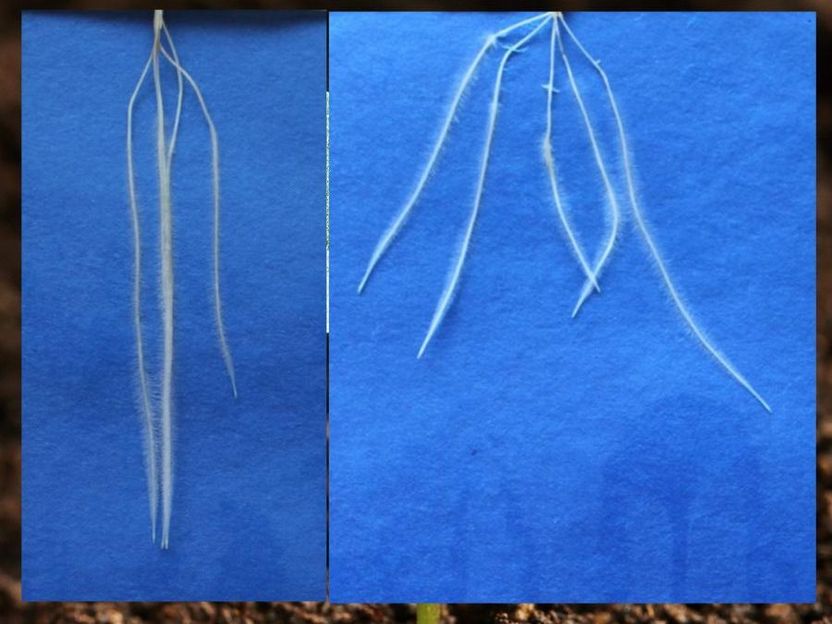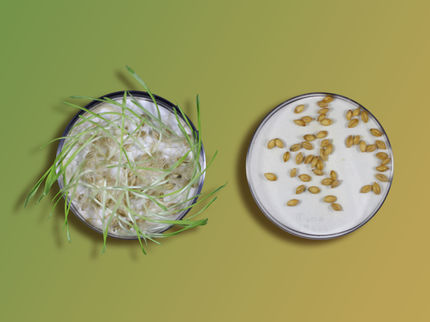Rare barley mutation with potential
Advertisement
The importance of the root system for the level of agricultural yields is often underestimated. Whether roots can effectively access water and nutrients also determines how resistant important crops are to drought and climate change. Researchers from the Universities of Bonn and Bologna (Italy) have discovered and described a mutant in barley: Its roots grow downwards much more steeply than normal. This discovery potentially offers a starting point for breeding more drought-resistant varieties. The study has now been published in PNAS.

Left: Seven-day-old barley roots of the egt2 mutant: they grow strictly downwards (hypergravitropic). ; r: For comparison, the root without the egt2 mutation: It grows in width and thus opens up a larger soil volume in search of nutrients.
Gwendolyn Kirschner
Barley is one of the most important cereals. Its uses range from beer brewing to groats, barley barley and barley flakes to barley flour. Some time ago, scientists led by Prof. Dr. Silvio Salvi from the University of Bologna discovered an unusual mutant of barley: its roots do not spread to the side as they normally do, but grow straight down. The scientists called this mutant "hypergravitropic" - i.e. following gravity much more strongly than its conspecifics. The teams led by Prof. Dr. Frank Hochholdinger from the Institute of Crop Science and Resource Conservation (INRES) at the University of Bonn and Prof. Salvi, together with other colleagues, investigated the causes behind this.
The researchers compared the genome of the mutant with normal barley plants. They discovered a mutation on chromosome number five, which they named "enhanced gravitropism 2" (egt2), which means "enhanced orientation to gravity". The "2" indicates that the team has another study in progress on a similar mutation (egt1). The scientists proved that egt2 is indeed responsible for the steeply downward-growing roots by artificially creating such a mutation in normally expressed barley plants using the CRISPR/Cas9 gene scissors. "The result shows a similar appearance of the roots," reports first author Dr. Gwendolyn K. Kirschner from INRES at the University of Bonn. "This allowed us to prove that we had identified the correct gene."
Roots in MRI
The scientists grew the small barley plants in seed paper or soil and recorded the root angles with a scanner and special software. They also used resources from the Jülich Research Centre: there, the barley grew in special "flower pots" that fit into a magnetic resonance tomograph. Using the imaging technique, the scientists "shone through" the soil and recorded the growth of the roots in this way.
Plants with the egt2 mutation react far more sensitively to the influence of gravity than normal specimens. The scientists demonstrated this by placing the roots of barley seedlings rotated 90 degrees to the direction of gravity. "As a result, the roots of the mutants grew significantly more in the direction of gravity than the comparison specimens without this mutation," says Dr. Kirschner.
Mutation is rare
The mutation is not common. "Many mutants have shorter or absent roots," Hochholdinger says. "But mutations that result in different root angles are relatively rare to find." With scientists from the John Innes Centre in Norwich, UK, the team was able to show that a very similar mutant also exists in wheat plants. "This shows that the gene is evolutionarily conserved," Hochholdinger reports. This means that this gene not only plays a significant role in barley, but also in other important cereals. Hochholdinger: "So it's worth taking a closer look."
The discovery of the mutation offers a potential starting point for new breeding, according to the scientists. "Steeper roots are advantageous when it comes to tapping water resources and mobile nutrients at greater depths," Hochholdinger says. On the other hand, a root system that grows wider penetrates a larger volume of soil and can therefore tap into nutrients over a larger area and gives the plants better stability. It therefore depends on the particular location which root system offers the best conditions for good yields. In drier regions, this could be the steep roots, and in areas with less nutrients, the shallower roots.
Starting point for breeding drought-adapted varieties
"So far, roots have been largely neglected in breeding," says Hochholdinger. But due to increased droughts as a result of climate change, the architecture of the root system could be of great importance in the future. In that case, the mutant with the vertical roots might play a role in the production of varieties adapted to climate change. The researchers have not yet been able to decipher the exact molecular function of the gene. However, the scientists at the University of Bonn want to investigate which signalling pathways the mutant influences in the barley plants in the ongoing study.
Participating institutions and funding:
In addition to the Universities of Bonn and Bologna, the Universities of Gießen and Cologne, the Leibniz Institute of Plant Genetics and Crop Plant Research in Gatersleben, the Research Centre Jülich, the Crop Bioninformatics Unit at INRES and the John Innes Centre Norwich are also involved in the study. The project was mainly funded by the German Research Foundation.
Note: This article has been translated using a computer system without human intervention. LUMITOS offers these automatic translations to present a wider range of current news. Since this article has been translated with automatic translation, it is possible that it contains errors in vocabulary, syntax or grammar. The original article in German can be found here.
Original publication
Gwendolyn K. Kirschner, Serena Rosignoli, Li Guo, Isaia Vardanega, Jafargholi Imani, Janine Altmüller, Sara G. Milner, Raffaela Balzano, Kerstin A. Nagel, Daniel Pflugfelder, Cristian Forestan, Riccardo Bovina, Robert Koller, Tyll G. Stöcker, Martin Mascher, James Simmonds, Cristobal Uauy, Heiko Schoof, Roberto Tuberosa, Silvio Salvi, and Frank Hochholdinger: ENHANCED GRAVITROPISM 2 encodes a STERILE ALPHA MOTIF-containing protein that controls root growth angle in barley and wheat, PNAS
Other news from the department science
Most read news
More news from our other portals
© 1997-2025 LUMITOS AG, All rights reserved





























































